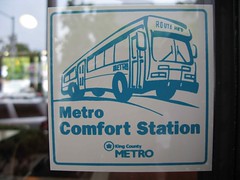Route 245 to Slow Down for Restroom Access

Photo by Oran Viriyincy.
Last November, the state Department of Labor and Industries (L&I) fined Metro for failing to provide adequate restrooms for bus drivers. The fine reflected longstanding problems along a number of Metro routes. Famously, Metro seemed incapable of ensuring the basic cleanliness of a portable serving eight buses an hour, at the Othello Station end of routes 36 and 50. But that was only one of many issues.
Metro acknowledged the problem in its response to L&I, and came up with an abatement plan that included a list of routes needing help. Some routes were addressed by paying 24-hour businesses near route ends to allow drivers access. But many other routes do not have such businesses near their ends. Starting this Saturday, three routes are changing to give drivers easier restroom access. More routes will see changes over time.
Most important to riders will be changes to routes 245 and 246 in Bellevue. There is no restroom at the Factoria end of route 245 or the Clyde Hill end of route 246. Both routes will be revised to give drivers time to use a restroom in the middle of the route: Eastgate P&R for the 245, and Bellevue Transit center for the 246. This means that riders from the affected end of the route will have to wait through a layover, or transfer to another bus, if they want to ride past the designated restroom point.
For route 246, a 30-minute coverage route that uses small buses, this isn't a big deal. Very few Clyde Hill riders ride past Bellevue Transit Center, and the change comes with a sweetener in the form of a very useful extension of the route to Yarrow Point Station.
But for route 245, the change is bigger news. Route 245, with 15-minute frequency, is a core service on the Eastside. It's the major crosstown route outside of downtown Bellevue, connecting Factoria, Eastgate, Bellevue College, Crossroads, Microsoft, and Kirkland. (Think of it as the "48 of the Eastside." ) Plenty of riders originate in Factoria and ride past Eastgate, and all of them will now have to wait or transfer at Eastgate on every trip (except a few late at night).
Metro's Jeff Switzer reassured me that this is an interim solution. But, even in the interim, it creates a major slowdown for a lot of riders. If this sort of solution is extended to some of the even busier core routes on Metro's list, such as the 11, 48, or 128, many more riders would be affected. Choice riders are not going to put up, and should not put up, with a 10- to 20-minute delay of service in the middle of their routes. Given the severity of the rider impact, it is probably worth cutting service at the margins to fund real solutions.
In some cases, Metro might be able to build small, standalone permanent comfort stations with running water, such as those that exist at the ends of a number of Seattle routes today. For example, it appears there is room for such a comfort station to be built near the Factoria terminal of route 245. In other cases, Metro might be able to extend or change routing so that riders are covered without delay. (Old route 65 in Lake City was a good example of this sort of routing: buses served north Lake City, then doubled back to Fred Meyer without passengers to provide drivers with restroom access.)
The other change is to cut route 73's "tail" on 20th Ave NE. Buses will lay over behind the Jackson Park QFC, together with route 65. This is not a major change for most riders, given that the "tail" largely overlaps with the main routing on 15th Ave NE.
I want to emphasize that I do not support just keeping things the way they are. Drivers need reliable access to clean, well-maintained restrooms at both ends of all but the shortest routes. But forcing passengers on busy core routes to wait through long layovers, like Metro will do on route 245, is not the right way to provide that access.